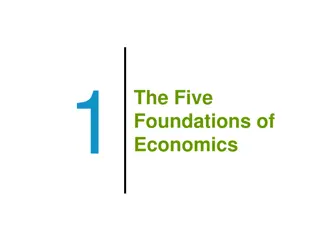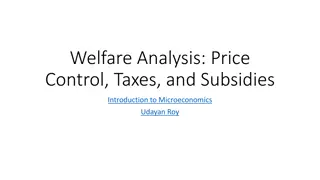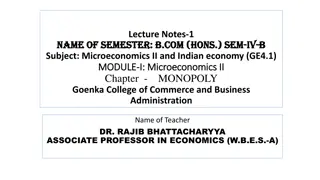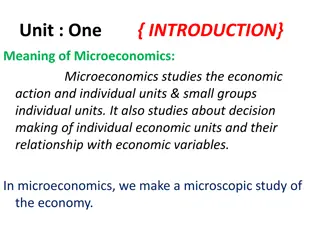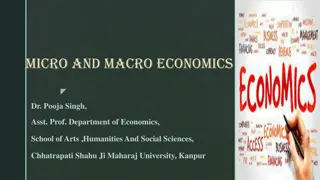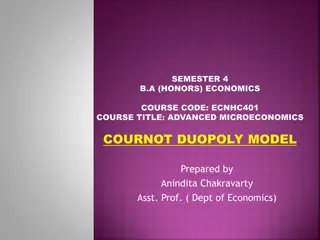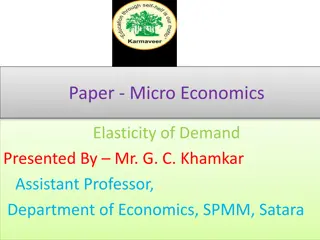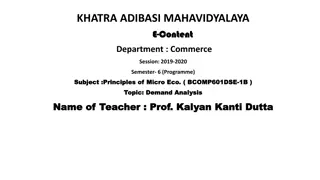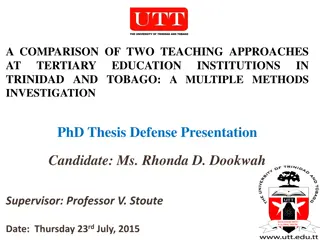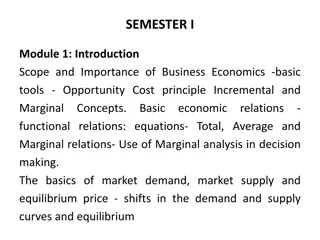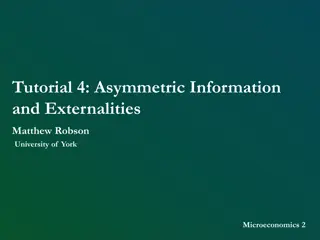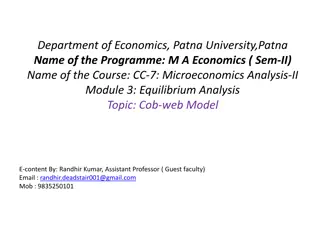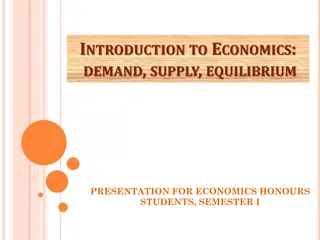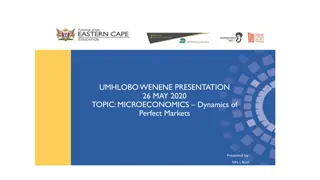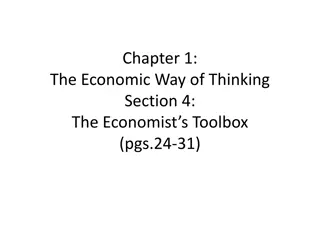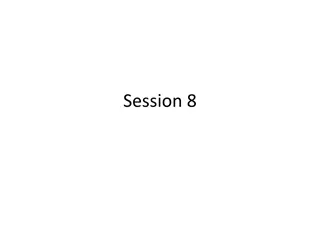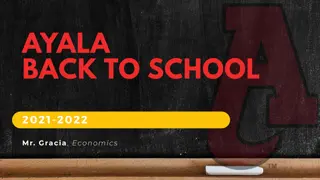Principles of Microeconomics
Learn how market systems work, analyze production possibilities frontier (PPF) and opportunity cost, and understand comparative advantage and trade in this chapter on scarcity and choices.
2 views • 31 slides
Understanding the Scope of Managerial Economics
Managerial economics plays a crucial role in decision-making processes within businesses, focusing on optimizing limited resources for profit maximization. It encompasses both microeconomics and macroeconomics, utilizing economic theories to analyze the business environment. Key aspects such as dema
2 views • 6 slides
Understanding Economics: Foundations and Concepts
Explore the core principles of economics, including scarcity, incentives, trade-offs, opportunity costs, and marginal thinking. Discover how these concepts shape individual decisions, market dynamics, and overall economic behavior. Learn about microeconomics and macroeconomics, and how they provide
0 views • 26 slides
Exploring Economics: Why Study, Skills Acquired, and Module Overview
Dive into the world of economics to understand why studying it is important and what skills you can develop. Explore modules covering microeconomics, macroeconomics, quantitative methods, international economics, and more, preparing you for a career in economic analysis and decision-making within th
0 views • 4 slides
Understanding Welfare Analysis in Microeconomics
Explore the impact of price control, taxes, and subsidies on total surplus and welfare in microeconomics. Learn about deadweight loss, government interventions, and the effects of policy decisions on economic outcomes. Gain insights into how quantity deviations from equilibrium affect different stak
0 views • 65 slides
Understanding Oligopoly in Microeconomics
Introduction to oligopoly, a market structure between perfect competition and pure monopoly. In oligopoly, only a few sellers offer similar or identical products, leading to a balance between cooperation and self-interest. Characteristics of an oligopoly market include interdependence among firms an
0 views • 46 slides
Understanding Monopoly in Microeconomics
A comprehensive discussion on the concept of monopoly, its sources of power, short-run and long-run equilibrium of a monopoly firm, price discrimination, and the social cost of monopoly. It also covers practical aspects like measuring monopoly power and the social implications of monopoly behavior s
0 views • 8 slides
Understanding the Importance of Microeconomics in Business Decision Making
Microeconomics focuses on the economic actions of individual units and small groups in the economy. It delves into decision-making processes, relationships with economic variables, market equilibrium, elasticity of demand and supply, consumer behavior, production theories, pricing practices, and wel
1 views • 29 slides
Understanding Microeconomics: Key Concepts and Applications
Microeconomics, as explained by Dr. Pooja Singh, focuses on the economic behavior of individual units like households, firms, and industries. It delves into how consumers, resource owners, and businesses interact within the economic system. The merits of microeconomics include aiding in policy-makin
4 views • 14 slides
Understanding the Cournot Duopoly Model in Advanced Microeconomics
The Cournot Duopoly Model, named after Augustin Cournot, is an economic model where competing firms independently choose quantities to produce simultaneously. It strikes a balance between monopoly and competition, resulting in stable Nash Equilibrium. While advantageous, it has limitations due to un
8 views • 5 slides
Understanding the Theory of Demand in Microeconomics
The theory of demand in microeconomics explores the concept of consumer willingness and ability to purchase goods and services at various prices. Factors influencing demand include price, related commodity prices, income levels, consumer preferences, population size, and distribution of income. The
1 views • 13 slides
Understanding Elasticity of Demand in Microeconomics
Elasticity of demand in microeconomics explores the qualitative and quantitative relationships between demand and price. It examines how changes in various factors affect consumer behavior and demand for goods and services. Factors such as price, consumer income, prices of related commodities, numbe
1 views • 8 slides
Understanding Demand in Microeconomics: Principles, Determinants, and Laws
Demand analysis in microeconomics involves studying the desire backed by purchasing power for specific commodities. It is influenced by various determinants such as price, income, consumer preferences, and expectations. The Law of Demand states that as the price of a commodity falls, the quantity de
0 views • 7 slides
Comparison of Teaching Approaches in Tertiary Education: A Multiple Methods Investigation
Ms. Rhonda D. Dookwah presents a Ph.D. thesis defense on comparing two teaching approaches in Trinidad and Tobago's tertiary education system. The study explores the effectiveness of Teacher-Centered Instruction (TCI) and Problem-Based Learning (PBL) through quantitative data analysis in subjects li
0 views • 87 slides
Understanding Business Economics Fundamentals
Business economics delves into the efficient allocation of scarce resources within a business context, focusing on principles such as opportunity cost, marginal analysis, market demand and supply, and strategic decision-making. It encompasses microeconomics and macroeconomics, studying both individu
0 views • 37 slides
Theories of Interest in Microeconomics II
Explore various theories of interest in economics, including the Classical Theory, Liquidity Preference Theory by Keynes, Productivity Theory, Abstinence Theory, Time-Preference Theory, Fisher's Time Preference Theory, and the Loanable Fund Theory. These theories offer different perspectives on the
0 views • 6 slides
Understanding Asymmetric Information and Externalities in Microeconomics
Explore the concepts of adverse selection, market inefficiency, signaling, and moral hazard arising from asymmetric information in microeconomics. Delve into scenarios like the Market for Lemons and health insurance to grasp how information deficiencies impact economic outcomes. Additionally, analyz
0 views • 22 slides
Understanding the Cob-Web Model in Microeconomics Analysis
The Cob-Web Model, first proposed by Nicholas Kaldor, explains cyclic fluctuations in farm product output and prices. It is based on lag concepts, with supply depending on previous prices in the agricultural sector. The model consists of three types of fluctuations: Convergent, Continuous, and Diver
0 views • 8 slides
Understanding Economics: Demand, Supply, and Equilibrium
Explore the fundamental concepts of economics, including the nature and scope of economics, demand, and its determinants. Learn about normative and positive economics, microeconomics, macroeconomics, and the factors affecting demand such as income, price of the good, and complementary goods. Gain in
0 views • 19 slides
Understanding Agribusiness Economics and Decision-Making
Agribusiness economics involves microeconomics and macroeconomics, managerial decision-making, and economic forecasting to analyze and improve the performance of firms in the food and fiber production and marketing system. Economic dashboards provide real-time insights for informed decisions, while
0 views • 23 slides
Understanding Dynamics of Perfect Markets in Microeconomics
Explore the dynamics of perfect markets in microeconomics through this presentation by Mrs. L. Booi. Learn about the short and long run production, cost and revenue curves, and the concepts of perfect markets and imperfect markets. Gain insights into how things behave and affect other markets in the
0 views • 23 slides
Understanding Economics: Tools and Concepts
Economics involves analyzing data, developing models, and using tools like charts, graphs, and tables. Economists study microeconomics focusing on individual elements and macroeconomics studying the economy as a whole.
0 views • 10 slides
Understanding Microeconomics and Macroeconomics in Economics
Microeconomics focuses on individual economic actors like households and firms, while Macroeconomics studies the economy as a whole, addressing questions related to income, prices, production, and government interventions. The relationship between Micro and Macro is highlighted, emphasizing the impo
0 views • 37 slides
Understanding Microeconomics and Macroeconomics in Economics
Explore the two subfields of economics - Microeconomics, focusing on individual decisions and market interactions, and Macroeconomics, examining the economy as a whole. Discover the key questions answered by Macroeconomics, the relationship between Micro and Macro, and the importance of economic gro
0 views • 37 slides
Top Tips for Sem 1 Microeconomics Exam
Master Sem 1 Microeconomics by focusing on key concepts, graphs, past papers, and essential equations. Clarify doubts early to strengthen your understanding, with a focus on supply, demand, and elasticity. These core topics are crucial for success. Practice past papers to improve problem-solving ski
14 views • 1 slides
Ayala Back to School 2021-2022 Information for Mr. Gracia's Economics Class
Get ready for the academic year with all the essential details for Mr. Gracia's Economics class at Ayala High School. The course covers topics such as Macroeconomics, Microeconomics, GDP, Inflation, Unemployment, S&D, Free Market, Monopolies, and Personal Finances. Stay updated on assignments, notes
0 views • 9 slides


